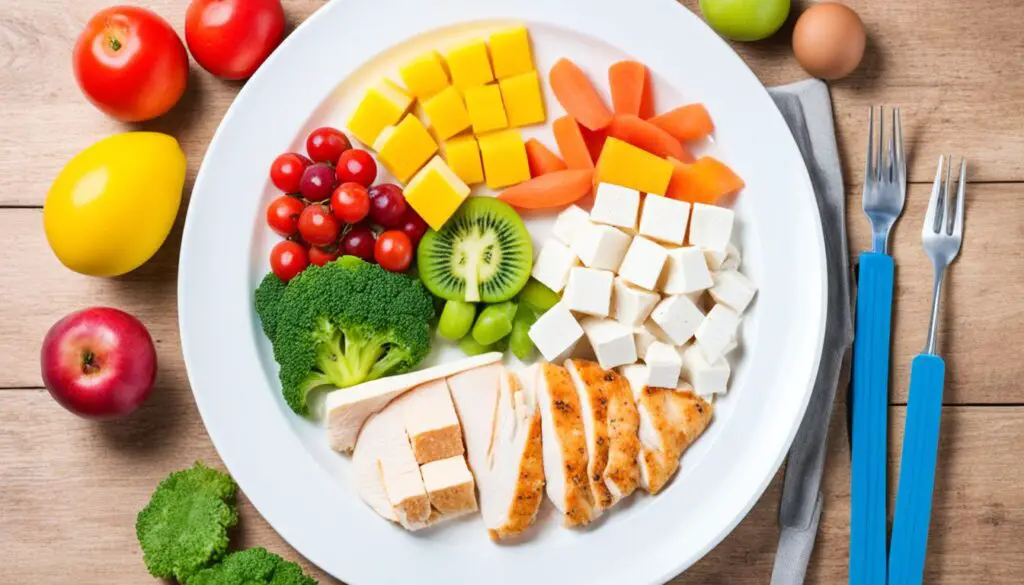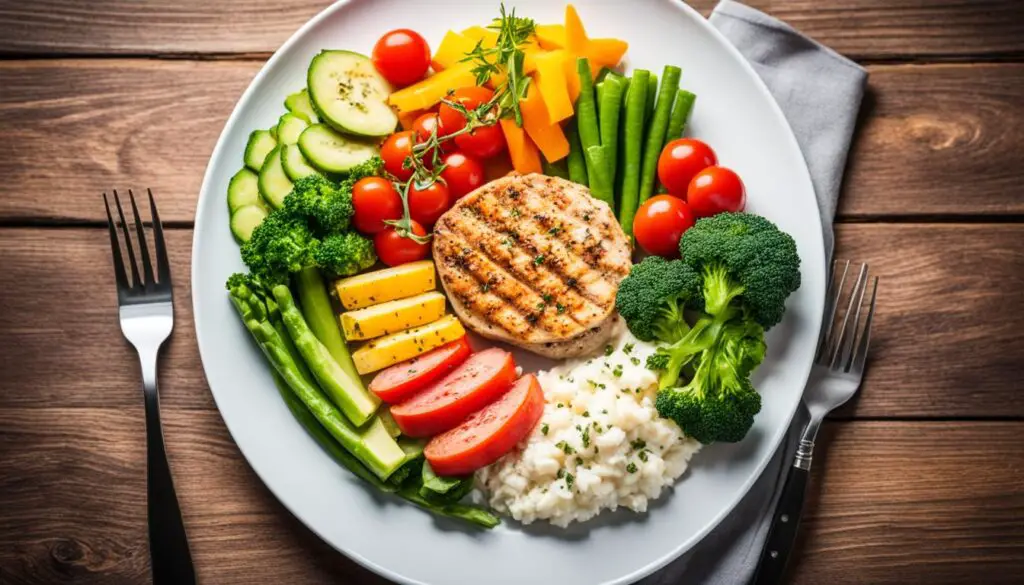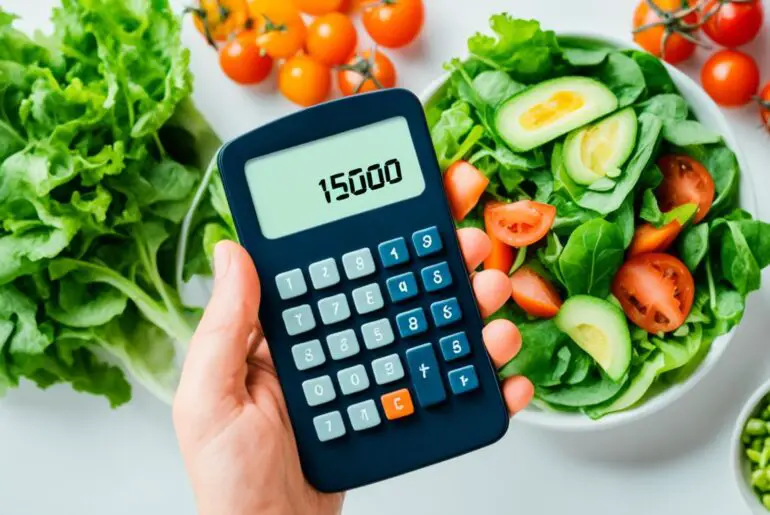Did you know that the HCG Diet has helped millions of people worldwide achieve significant weight loss? The incredible success of this diet has made it a go-to option for individuals looking to shed pounds quickly and safely. However, the real challenge lies in maintaining that weight loss over the long term. This is where the HCG Diet maintenance phase comes into play.
During the maintenance phase, you’ll learn how to transition from the weight loss phase to a sustainable lifestyle that helps you maintain your new weight. It’s a crucial step that requires following specific guidelines and making informed choices to ensure lasting success.
In this article, I will share valuable tips and guidelines on how to start HCG Diet maintenance and maintain your weight loss effectively. By understanding the principles of the maintenance phase and implementing them correctly, you can achieve a healthier, happier you.
Key Takeaways:
- Starting the HCG Diet maintenance phase is crucial for maintaining weight loss.
- Follow specific guidelines during the maintenance phase to ensure long-term success.
- Gradually transition from the weight loss phase to a sustainable lifestyle.
- Learn how to make informed choices to maintain your new weight.
- Implement the principles of HCG Diet maintenance effectively for lasting results.
Understanding Phase 3 of the HCG Diet
Phase 3 of the HCG Diet is the maintenance phase and should be followed for 6 weeks. During this phase, you must avoid carbohydrates for the first 3 weeks and slowly reintroduce them into your diet in the next 3 weeks. It is important to weigh yourself daily to monitor any weight gain and stay within 2 lbs of your last injection weight (liw). Following the 500 calorie diet for 72 hours after your last injection is also essential. This phase aims to reset your metabolism and train your body to maintain your new weight.
After completing the intense weight loss phase of the HCG Diet, it is crucial to transition into the maintenance phase to solidify your newfound weight loss and prevent any rebound effects. This phase, also known as Phase 3, plays a pivotal role in training your body to maintain the achieved weight loss without the aid of the HCG hormone. Understanding Phase 3 of the HCG Diet and adhering to its guidelines is vital for long-term success.
Phase 3 of the HCG Diet, also referred to as the HCG Diet maintenance phase, typically lasts for 6 weeks. It is a crucial period that focuses on stabilizing your weight and teaching your body how to maintain it. During this phase, you will gradually reintroduce certain foods into your diet while closely monitoring your daily caloric intake and weight fluctuations. This phase is essential for the successful transition from the rigorous weight loss phase to the more sustainable maintenance phase of the HCG Diet.
The HCG Diet maintenance program aims to reset your metabolism and establish new dietary habits that will help you maintain your weight loss. It involves strict adherence to specific guidelines, including a phased reintroduction of carbohydrates and careful monitoring of your weight. By following the HCG Diet maintenance plan, you can ensure that your body adjusts to its new weight and learns to maintain it without the need for continuous weight loss efforts.
During the initial 3 weeks of Phase 3, it is essential to avoid carbohydrates entirely. This includes foods such as sugar, grains, and starchy vegetables. By avoiding carbohydrates during this period, your body is given the opportunity to readjust and stabilize without the risk of triggering weight gain. The subsequent 3 weeks of Phase 3 involve gradually reintroducing carbohydrates back into your diet, allowing your body to adjust to a wider range of foods while still maintaining your weight loss.
Weighing yourself daily is a critical component of the HCG Diet maintenance phase. By monitoring your weight, you can quickly identify any fluctuations and make necessary adjustments to your diet or exercise routine. It is essential to stay within 2 lbs of your last injection weight (liw) to ensure optimal results. If your weight exceeds this range, it may be an indication of overeating or reintroducing carbohydrates too quickly, requiring you to make adjustments to bring your weight back within the desired range.
Following the 500 calorie diet for 72 hours after your last HCG injection is another crucial aspect of Phase 3. This short period of reduced calorie intake helps solidify the accomplishments of the weight loss phase and prepares your body for the upcoming maintenance phase. It allows your metabolism to reset and readjust to the new dietary changes, ensuring a smoother transition into a higher caloric intake while maintaining your weight loss.
Understanding Phase 3 of the HCG Diet and its guidelines is vital for a successful maintenance phase. By diligently following the HCG Diet maintenance plan, you can train your body to maintain the weight loss achieved during the HCG Diet. The HCG Diet maintenance program provides a structured approach to resetting your metabolism and stabilizing your weight, offering a sustainable path to long-term weight maintenance.
Protein Intake in Phase 3

In the first few days of Phase 3 of the HCG Diet maintenance protocol, it is important to focus on replenishing your body with adequate protein. Protein-rich foods should be included in your diet to support muscle repair and recovery. Gradually increasing your caloric intake during this phase is also crucial for transitioning from the low-calorie phase to maintaining your new weight.
To ensure success during Phase 3 of the HCG Diet maintenance instructions, it is recommended to avoid extremely low-calorie diets. While it may be tempting to continue restricting calories, doing so can set your metabolism at a lower rate, making it more difficult for your body to adjust to consuming higher calories. The goal is to train your body to accept and process higher calorie intake while still maintaining your weight loss.
Include a variety of protein-rich foods in your meals during Phase 3. Some examples of protein sources include lean meats like chicken, turkey, and fish, as well as eggs, tofu, and low-fat dairy products. These foods not only provide essential amino acids for muscle maintenance, but they also help you feel fuller for longer periods, reducing the likelihood of overeating.
Remember to listen to your body’s hunger and satiety cues as you increase your protein intake and gradually adjust your caloric intake. It’s important to strike a balance that promotes sustainable weight maintenance and supports your overall health and well-being.
Benefits of Sufficient Protein Intake
Ensuring sufficient protein intake during Phase 3 of the HCG Diet maintenance program offers several benefits. Here are some of the key advantages:
- Promotes muscle repair and maintenance: Protein is essential for building and repairing muscle tissue, which can be beneficial if you have incorporated exercise into your routine during the maintenance phase.
- Supports satiety and appetite control: Protein-rich foods are generally more filling, helping to reduce cravings and prevent overeating, which can contribute to weight maintenance.
- Aids in weight loss maintenance: Consuming adequate protein can help prevent muscle loss and promote fat loss, facilitating continued weight loss maintenance after completing the HCG Diet program.
By prioritizing protein intake, you can optimize your transition from the weight loss phase to successful weight maintenance in Phase 3 of the HCG Diet protocol.
Expert Tip: Protein Tracking and Meal Planning
Tracking your protein intake can be helpful during Phase 3 of the HCG Diet maintenance instructions. There are various mobile apps and online tools available that can assist you in monitoring your daily protein consumption. These tools allow you to input your food choices and quantities, helping you ensure that you are meeting your protein goals.
Remember to incorporate protein into each of your meals and snacks. Plan your meals in advance to guarantee that you have sufficient protein sources readily available. This proactive approach can help you maintain a balanced diet and support your weight maintenance goals.
Consulting with a registered dietitian or nutritionist who specializes in the HCG Diet maintenance phase can provide personalized guidance on protein intake, dietary planning, and incorporating protein-rich foods into your meals.
Stay committed to your HCG Diet maintenance journey by prioritizing protein intake and gradually increasing your caloric intake to support long-term weight maintenance success. Taking these steps will help solidify healthy habits and ensure that you maintain the positive outcomes achieved during the HCG Diet program.
Carbohydrate Restrictions in Phase 3
During Phase 3 of the HCG Diet maintenance, it is important to be mindful of your carbohydrate intake. Carbohydrates such as sugar, rice, bread, potatoes, pastries, cereal, crackers, and even Grissini breadsticks should be avoided to maintain the progress you made during the weight loss phase. It’s also crucial to be cautious of condiments that may contain hidden sugars or starches, as they can hinder your weight maintenance efforts.
While certain vegetables like beans and legumes contain more carbohydrates, they can be consumed in moderation due to their protein and fiber content. However, corn, peas, yams, and sweet potatoes should be completely avoided during this phase to ensure optimal results. Reading food labels and checking for sugar and carbohydrate content is essential in making informed choices and sticking to the HCG Diet maintenance instructions.
In summary, adhering to the carbohydrate restrictions in Phase 3 is key to the success of your HCG Diet maintenance schedule. By avoiding certain high-carb foods and being mindful of hidden sugars, you can continue to support your weight loss journey and maintain your desired results.
Dairy, Fruits, and Nuts in Phase 3
During Phase 3 of the HCG Diet maintenance plan, it is important to incorporate dairy, fruits, and nuts into your diet, but in moderation. These food groups provide essential nutrients while maintaining the balance required for HCG Diet maintenance success. Here are some guidelines to follow:
Dairy:
- Yogurt: Choose plain yogurt and add fresh fruit for natural sweetness. Avoid flavored types that may contain added sugars.
- Cheese: Opt for low-fat cheeses as part of your dairy intake. These can be enjoyed in small quantities.
Fruits:
- Berries: Include berries like strawberries, blueberries, and raspberries as they are lower in sugar compared to other fruits.
- Apples: Apples are another great choice, providing fiber and natural sweetness.
It is important to approach certain fruits with caution due to their high sugar content. Bananas, pineapple, and melons should be consumed sparingly, keeping in mind the overall sugar intake during the HCG Diet maintenance phase.
Nuts:
Nuts can be included in your HCG Diet maintenance plan, but moderation is key. Opt for raw nuts and seeds to avoid added oils or seasonings that may interfere with the maintenance process. Here are some options:
- Almonds
- Walnuts
- Pistachios
- Chia seeds
Remember to monitor your weight daily and make adjustments if necessary. Achieving HCG Diet maintenance success requires careful attention to portion sizes and overall caloric intake. Incorporating dairy, fruits, and nuts in moderation can contribute to a balanced and fulfilling diet during Phase 3.
Soups, Fats/Oils, and Supplements in Phase 3

During Phase 3 of the HCG Diet maintenance program, there are specific guidelines regarding soups, fats/oils, and supplements. Here’s what you need to know:
Soups:
Only broth-based soups are allowed during Phase 3. These soups should not contain any thickening agents or noodles. Stick to clear and light soups to maintain the integrity of the HCG Diet maintenance instructions. Broth-based soups provide nourishment while still adhering to the guidelines of this phase.
Fats/Oils:
Fats and oils can be consumed in moderation during Phase 3 of the HCG Diet maintenance program. However, it is important to choose healthy fats and oils. Opt for sources like olive oil, avocado oil, and coconut oil. These fats provide essential nutrients and add flavor to your meals. Remember to use them sparingly to stay within the guidelines.
Supplements:
If you were previously taking supplements, you can continue using them during Phase 3. However, it is crucial to ensure that the supplements you choose are compatible with the HCG Diet maintenance phase. Consult with a healthcare professional for personalized guidance on supplement use to ensure that they align with your specific needs and the HCG Diet maintenance program.
Following these guidelines for soups, fats/oils, and supplements will help you stay on track with the HCG Diet maintenance instructions and program. Remember to prioritize your health and consult with a healthcare professional for personalized advice.
Physical Activity in Phase 3
During Phase 3 of the HCG Diet, physical activity plays a vital role in achieving HCG Diet maintenance success and following a comprehensive HCG Diet maintenance plan. Engaging in regular exercise not only supports weight maintenance but also contributes to overall health and well-being.
As you transition into Phase 3, you have the freedom to choose any form of exercise or physical activity that suits your preferences and capabilities. Whether it’s walking, jogging, swimming, cycling, or participating in fitness classes, find an activity that you enjoy and can incorporate into your routine.
Regular exercise helps maintain muscle tone and boosts metabolism, which aids in burning calories and preventing weight regain. It also provides numerous other health benefits, such as improved cardiovascular fitness, increased energy levels, and enhanced mood.
Remember to listen to your body and start with activities that align with your current fitness level. Gradually increase the intensity and duration of your workouts as your stamina improves. Prioritize consistency rather than intensity, aiming for at least 150 minutes of moderate-intensity exercise or 75 minutes of vigorous-intensity exercise each week.
It is crucial to combine both cardiovascular exercises, such as brisk walking or cycling, and strength training exercises, such as weightlifting or bodyweight workouts, to maximize the benefits of physical activity during Phase 3.
Here are some popular exercise options to consider during the HCG Diet maintenance phase:
- Brisk walking: A low-impact cardiovascular exercise that can be easily incorporated into your daily routine.
- Cycling: Whether outdoors or on a stationary bike, cycling is an excellent cardiovascular exercise that is gentle on the joints.
- Swimming: Provides a total body workout, offering both cardiovascular benefits and muscle toning.
- Dancing: A fun way to burn calories while enjoying music and improving coordination.
- Resistance training: Incorporating weights or resistance bands into your routine helps build lean muscle, which increases metabolism and improves body composition.
- Pilates or yoga: Enhances flexibility, strength, and balance while promoting relaxation and stress reduction.
Remember to consult with a healthcare professional before starting any new exercise program, especially if you have specific medical conditions or concerns. They can provide personalized advice and guidance based on your individual needs.
Integrating physical activity into your daily routine during Phase 3 not only supports your HCG Diet maintenance plan but also sets the foundation for a healthy and active lifestyle long after completing the HCG Diet protocol.
| Benefits of Physical Activity during Phase 3 | Examples of Physical Activities |
|---|---|
| Supports weight maintenance and prevents weight regain | Brisk walking, cycling, swimming |
| Improves cardiovascular fitness | Dancing, aerobic classes, cardio machines |
| Increases energy levels | Pilates, yoga, strength training |
| Enhances mood and reduces stress | Outdoor activities, group exercises, team sports |
| Builds lean muscle and improves body composition | Resistance training, weightlifting |
Embrace the opportunity to stay active and make physical activity a regular part of your life during Phase 3. By incorporating exercise into your HCG Diet maintenance plan, you can optimize your results, maintain your weight loss, and enjoy the long-term benefits of a healthier, more active lifestyle.
Tips for Successful HCG Diet Maintenance

After completing the HCG Diet, it is crucial to follow certain tips and guidelines to maintain your weight successfully in the long term. By gradually increasing your calorie intake, reintroducing foods in moderation, establishing an exercise routine, and monitoring your weight regularly, you can ensure sustainable weight loss success.
- Gradually increase your calorie intake: Instead of abruptly jumping back to your regular calorie consumption, slowly increase your daily intake over time. This gradual approach helps your body adjust and prevents weight regain. Aim to increase your calories by around 200 kcal per week until you reach the recommended daily range for weight maintenance.
- Reintroduce foods in moderation: While it may be tempting to indulge in all the foods you’ve missed during the HCG Diet, it’s essential to reintroduce them gradually and in moderation. Start with low-carb and low-fat options and monitor your weight closely. If you notice any significant weight gain or adverse effects, make necessary adjustments to your diet.
- Establish an exercise routine: Regular physical activity is crucial for maintaining weight loss and overall health. Create an exercise routine that includes both cardiovascular exercises and resistance training. Aim for at least 75 minutes of vigorous exercise or 150 minutes of moderate exercise per week. Choose activities that you enjoy and can sustain in the long term.
- Monitor your weight regularly: Keep track of your weight on a regular basis, ideally daily or at least a few times a week. This allows you to identify any changes or fluctuations promptly. If you notice any significant weight gain, make necessary adjustments to your calorie intake or exercise routine to get back on track.
Following these tips for successful HCG Diet maintenance will help you maintain your weight loss and achieve long-term success. Remember, consistency and patience are key. Listen to your body, make adjustments as needed, and embrace a healthy lifestyle to enjoy the benefits of your hard work.
The Importance of Gradual Calorie Increase

After completing the HCG Diet, it is important to gradually increase your calorie intake to maintain your weight loss and prevent regaining the lost weight. Rapidly increasing calorie intake can confuse your body and lead to unwanted weight gain. To ensure successful HCG Diet maintenance, it is recommended to follow a gradual calorie increase plan.
Start by increasing your daily calorie intake by 200 kcal per week. This incremental approach allows your body to adjust to the additional calories and prevents it from going into a state of panic, where it may store excess calories as fat. Gradually increasing your calorie intake also helps to reset your metabolism and establish a sustainable eating pattern.
Continue increasing your calorie intake by 200 kcal every week until you reach the recommended daily calorie range for optimum weight maintenance. The exact calorie range may vary depending on individual factors such as age, gender, height, and activity level. A common guideline is to aim for a daily calorie intake of around 1500 kcal for weight maintenance.
Monitoring your weight throughout the gradual calorie increase process is crucial. Regular weigh-ins will help you assess if the rate of calorie increase is appropriate for your body’s needs. If you notice any unexpected weight fluctuations, you can adjust your calorie intake accordingly.
Remember, the HCG Diet maintenance plan is designed to help you maintain the weight loss achieved during the HCG Diet phase. By gradually increasing your calorie intake and monitoring your weight, you can successfully navigate the transition from weight loss to weight maintenance, ensuring long-term success in maintaining your new weight.
Reintroducing Foods into Your Diet

After completing the HCG Diet, it is important to gradually reintroduce sugars and starchy foods into your diet. This process should be approached with caution to maintain the success you’ve achieved during the maintenance phase. To ensure a smooth transition, follow these HCG Diet maintenance instructions:
- Start with low-carb and low-fat options: Begin by incorporating foods that are low in carbohydrates and fats. This will help your body adjust to the reintroduction of these nutrients without causing any drastic fluctuations in your weight.
- Moderate your consumption: Control your portion sizes and monitor your calorie intake during this period. It’s important not to overindulge in sugary or starchy foods, as this can lead to weight regain. Moderation is key to maintaining your HCG Diet success.
- Monitor your weight closely: Keep a close eye on your weight during the reintroduction phase. This will allow you to make any necessary adjustments to your diet and ensure that you stay on track with your weight maintenance goals.
- Be patient and allow your body to adjust: Remember that it typically takes about nine weeks for a complete metabolism reset. Give your body time to adapt to the changes and be patient with the process. Slow and steady progress is more sustainable in the long run.
By following these HCG Diet maintenance instructions, you can successfully reintroduce foods into your diet while maintaining the achievements you’ve made. Be mindful of your choices, stay committed to your weight maintenance goals, and enjoy the benefits of a healthier lifestyle.
Benefits of Reintroducing Foods Gradually
Gradually reintroducing sugars and starchy foods into your diet after completing the HCG Diet provides several benefits:
- Prevents weight regain: By gradually reintroducing these foods, you can avoid sudden weight gain and maintain the results you’ve achieved during the weight loss phase.
- Stabilizes blood sugar levels: Slowly adding sugars and starchy foods back into your diet helps stabilize your blood sugar levels, preventing spikes and crashes.
- Reduces cravings: By gradually reintroducing these foods, you can prevent intense cravings and maintain better control over your eating habits.
- Maintains metabolic balance: Gradually increasing your caloric intake can help your metabolism adjust and maintain a healthy balance.
Remember, the HCG Diet maintenance phase is a crucial part of your weight loss journey. Follow these instructions, be mindful of your choices, and stay committed to your goals for long-term success.
Establishing an Exercise Routine

Regular exercise is an essential component of maintaining weight loss after completing the HCG Diet. Incorporating physical activity into your routine helps boost your metabolism and prevent weight regain. To establish an effective exercise routine, follow these tips:
1. Choose activities you enjoy:
Select workouts that you find enjoyable and motivating. This will increase the likelihood of sticking to your exercise routine in the long term. Whether it’s jogging, swimming, cycling, or dancing, find activities that suit your preferences and fit into your lifestyle.
2. Aim for the recommended weekly exercise duration:
The American Heart Association recommends at least 150 minutes of moderate-intensity exercise or 75 minutes of vigorous exercise per week. Spread this duration across several days for optimal benefits. Moderate-intensity exercises include brisk walking, cycling, or water aerobics, while vigorous exercises may include running, swimming laps, or high-intensity interval training (HIIT).
3. Include cardiovascular exercises:
Cardiovascular exercises are excellent for burning calories and improving heart health. Engage in activities that elevate your heart rate and make you break a sweat. Examples include jogging, cycling, swimming, or participating in group fitness classes.
4. Incorporate resistance training:
Resistance training builds lean muscle mass, which helps boost your metabolism and improve body composition. Include exercises that target major muscle groups, such as weightlifting, bodyweight exercises, or using resistance bands. Aim for at least two to three resistance training sessions per week.
5. Gradually increase intensity and duration:
As you adapt to your exercise routine, gradually increase the intensity or duration of your workouts. This progression will challenge your body and promote further fitness improvement. However, be mindful of your body’s limitations and avoid pushing yourself too hard, as this can lead to injuries.
6. Listen to your body:
Pay attention to any signs of fatigue, pain, or discomfort during exercise. It’s important to listen to your body and make modifications or seek professional advice if needed. Always prioritize safety and make adjustments to your routine as necessary.
Remember, consistency is key when it comes to maintaining your weight loss. Stick to your exercise routine and make it a habit. Celebrate your progress along the way and enjoy the physical and mental benefits that regular exercise brings.
Conclusion
Maintaining the weight loss achieved through the HCG Diet requires commitment to a well-designed HCG Diet maintenance plan. By following the guidelines provided during the maintenance phase, you can ensure long-term success in weight maintenance.
A key factor in sustaining your weight loss is gradually increasing your calorie intake. This allows your body to adjust and prevent potential weight regain by avoiding sudden calorie surpluses. Reintroducing foods gradually and in moderation also helps in maintaining the progress you have made, while establishing an exercise routine supports your metabolism and overall health.
Regular monitoring of your weight is essential to make any necessary adjustments to your HCG Diet maintenance plan. By staying vigilant and adhering to these HCG Diet maintenance tips, you can maintain your weight loss and enjoy the benefits of a healthier and more fulfilling lifestyle.
FAQ
How do I start the HCG Diet maintenance phase?
To start the HCG Diet maintenance phase, you should follow specific guidelines. Begin by avoiding carbohydrates for the first 3 weeks and slowly reintroducing them in the next 3 weeks. Weigh yourself daily and stay within 2 lbs of your last injection weight. Follow the 500 calorie diet for 72 hours after your last injection to reset your metabolism.
What foods should I avoid during Phase 3 of the HCG Diet?
In Phase 3, it is important to avoid carbohydrates such as sugar, rice, bread, potatoes, pastries, cereal, crackers, and Grissini breadsticks. Certain vegetables and fruits with high sugar content should also be approached with caution. Read labels and check for sugar and carbohydrate content in food items.
Can I consume dairy products, fruits, and nuts during Phase 3?
Yes, dairy products can be consumed in moderation during Phase 3. Choose plain yogurt with added fruit or low-fat cheeses. Fruits should also be consumed in moderation, with a preference for berries and apples. Nuts and seeds can be included in your diet, but monitor your weight and consume them in moderation.
What should I include in my diet during Phase 3 in terms of soups, fats/oils, and supplements?
Only broth-based soups are allowed in Phase 3, without thickening agents or noodles. Fats and oils can be consumed in moderation. You can continue taking any supplements you were using, but make sure they are compatible with the HCG Diet maintenance phase. Consult with a healthcare professional for personalized guidance.
Can I continue exercising during Phase 3 of the HCG Diet?
Yes, physical activity is allowed and encouraged during Phase 3. Engage in any form of exercise or physical activity that suits your preferences and capabilities. Regular exercise supports weight maintenance and overall health.
How do I ensure successful HCG Diet maintenance?
For successful HCG Diet maintenance, gradually increase your calorie intake, reintroduce foods in moderation, establish an exercise routine, and monitor your weight regularly. Following these strategies will help you maintain your weight loss and enjoy a healthier lifestyle.
Why is a gradual calorie increase important in HCG Diet maintenance?
Gradually increasing your calorie intake after completing the HCG Diet prevents weight regain. Start by increasing your calorie intake by 200 kcal per week until you reach the recommended daily calorie range. This allows your body to adjust and avoid storing excess calories as fat.
How do I reintroduce foods into my diet after the HCG Diet?
After completing the HCG Diet, gradually reintroduce sugars and starchy foods into your diet. Start with low-carb and low-fat options and moderate your consumption. Monitor your weight closely and make adjustments if necessary. Allow your body about nine weeks for a complete metabolism reset.
How do I establish an exercise routine after the HCG Diet?
To establish an exercise routine after the HCG Diet, incorporate at least 75 minutes of vigorous exercise or 150 minutes of moderate exercise per week. Choose activities you enjoy and that fit into your lifestyle. Cardiovascular exercises and resistance training are recommended for optimal results.




